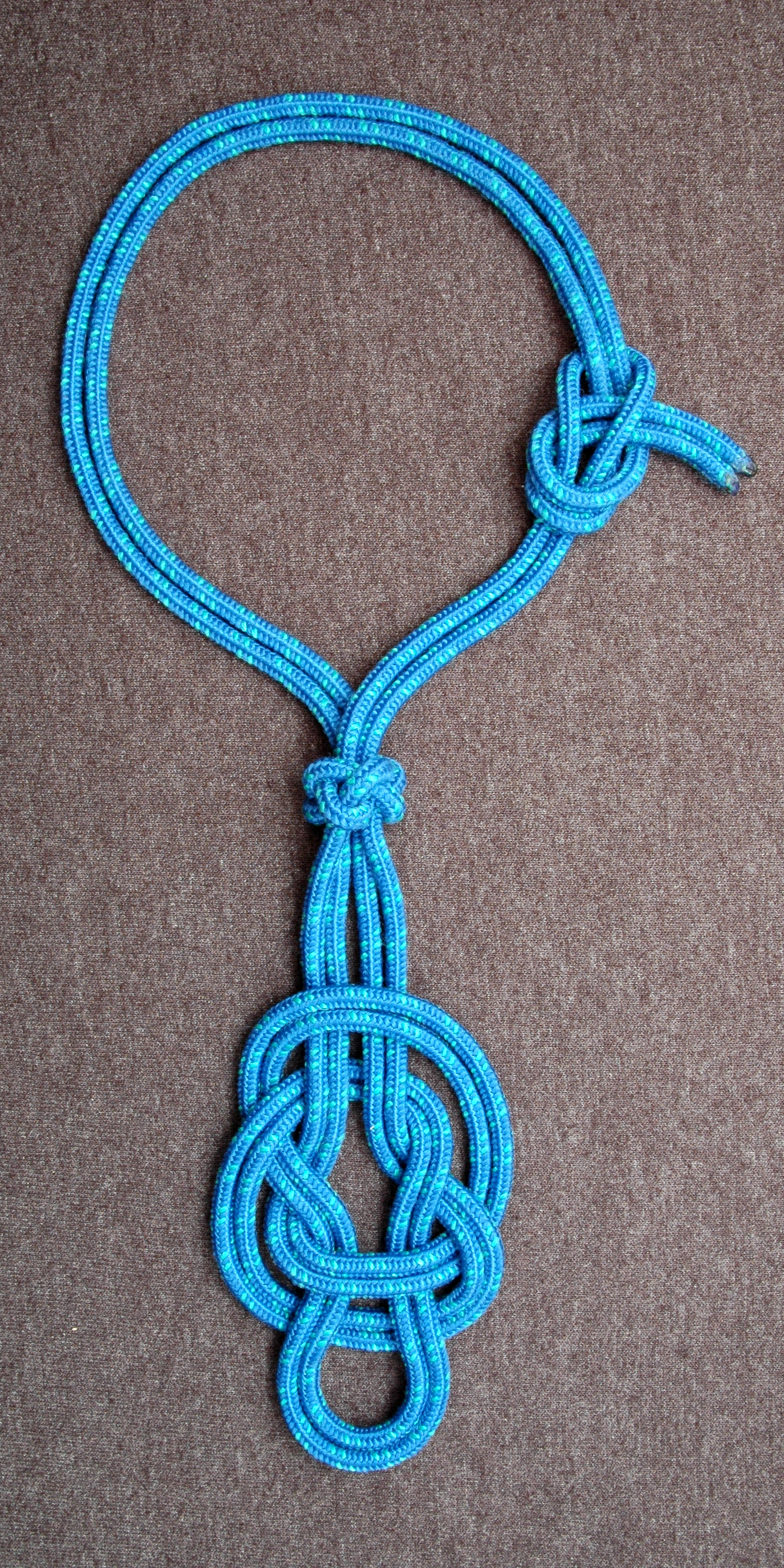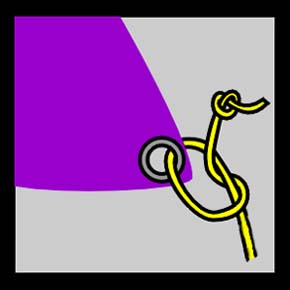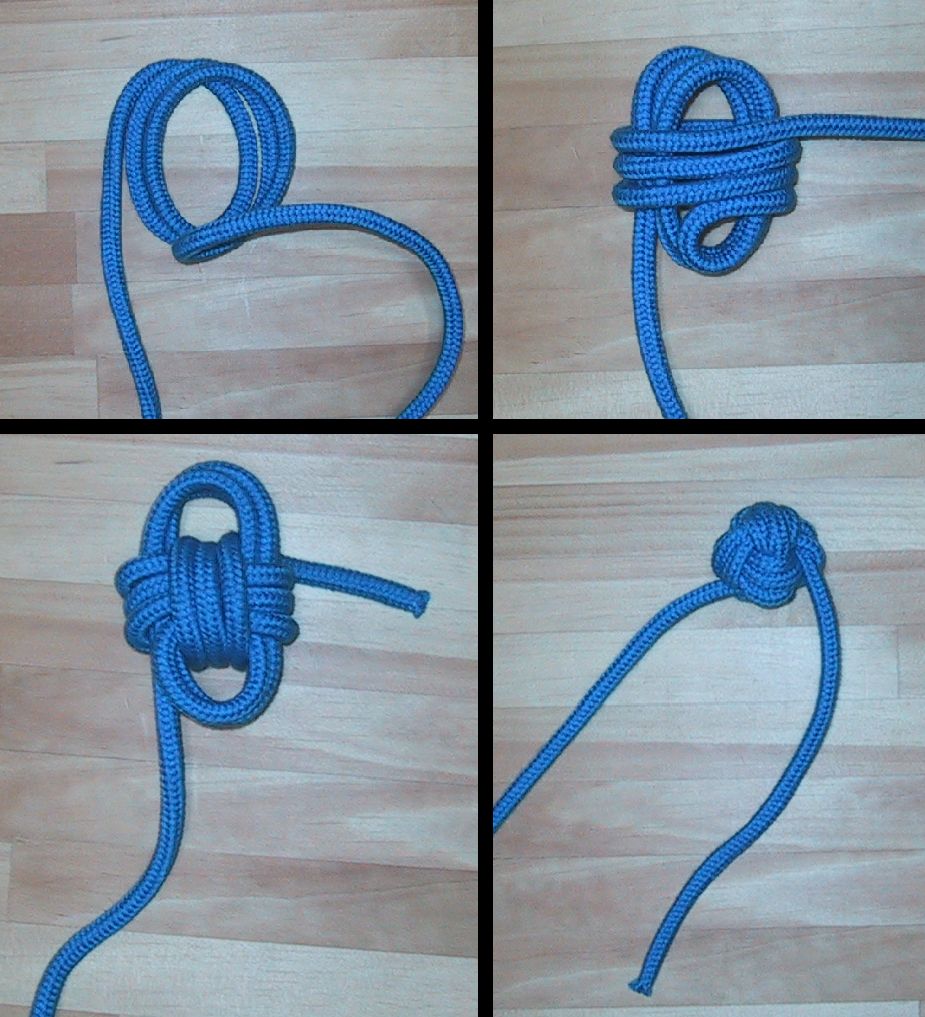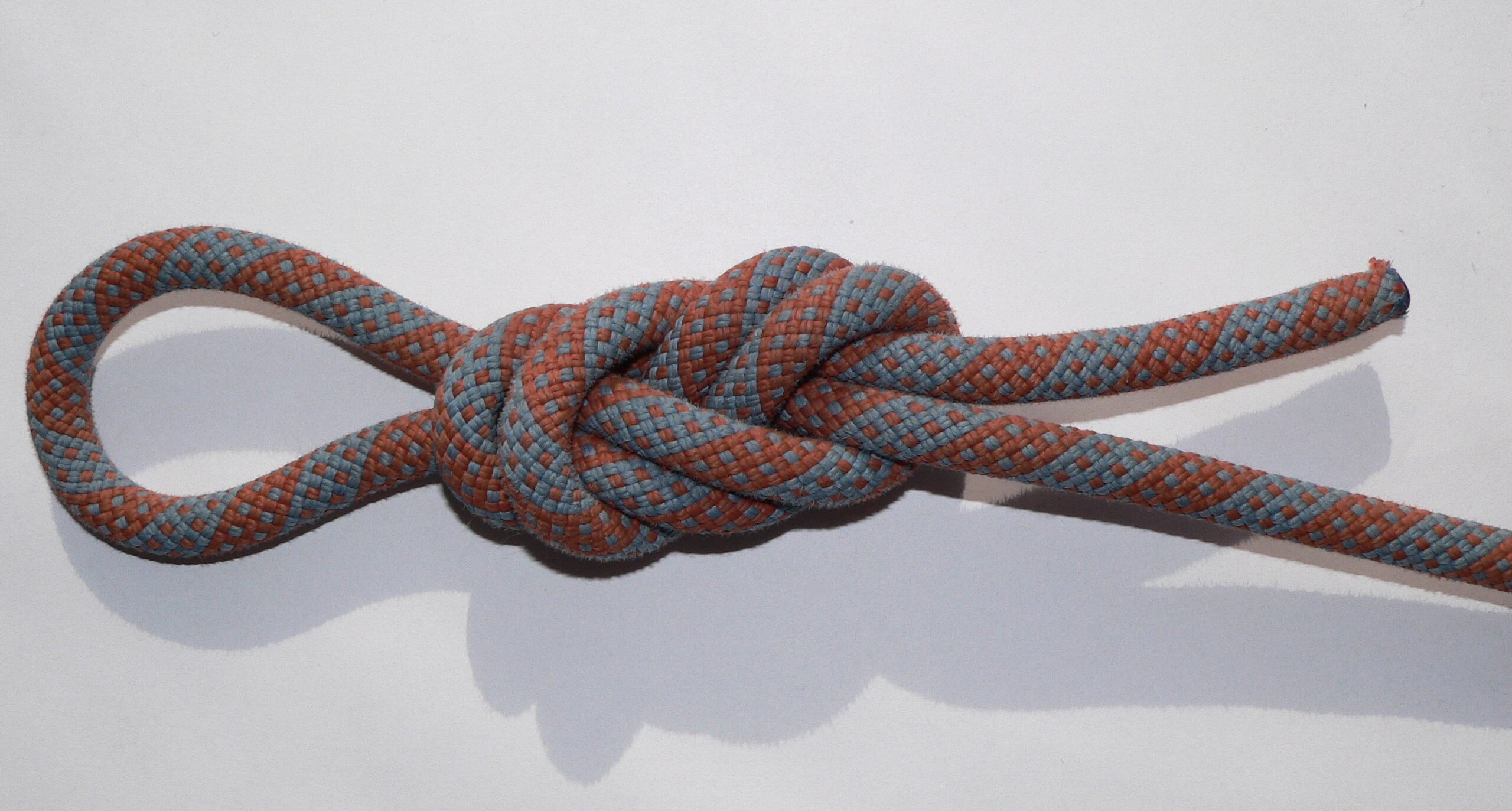|
Button Knot
A button knot is a knot that forms a bulge of thread. Button knots are essentially stopper knots, but may be esthetically pleasing enough to be used as a button on clothes. There are many methods for tying button knots, such as the Chinese button knot, the Celtic button knot and the monkey fist. ''The Ashley Book of Knots'' contains over a hundred examples. File:CiftIpteDugmeTekkat.jpg, Celtic button knot single, with 4 steps of tying it File:CiftIpteDugmeIkikat.JPG, Celtic button knot double, flat and tightened forms File:DirsekteTekIpteDugmeHalkasi.JPG, Celtic button knot formed on the bight, untightened - flat File:DirskteTekIpteDugmeCiftKat.JPG, Celtic button knot formed on the bight, tightened File:CiftIpteDugmeOnden.JPG , Chinese button knot front side File:CiftIpteDugmeArkadan.JPG , Chinese button knot back side File:ÇiftİpteFenerGerdelFenerGerdelKöstekCevizi-1.jpg , Rose knot on 2 ropes step1 walll File:ÇiftİpteFenerGerdelFenerGerdelKöstekCevizi-2.jpg , Rose knot ... [...More Info...] [...Related Items...] OR: [Wikipedia] [Google] [Baidu] |
Fiador Knot
The fiador knot (also Theodore knot) is a decorative, symmetrical knot used in equine applications to create items such as rope halters, hobbles, and components of the '' fiador'' on some hackamore designs. As traditionally described, it is a four strand diamond knot in which six of the eight ends loop back into the knot, thus allowing it to be tied with a single line. While a specific knot is discussed in this article, the fiador knot has also been treated as an entire class of multi-strand knots similarly made with a single line. Etymology The origin of the variant name "Theodore knot", used in the United States, is a corruption of the Spanish ''fiador''. American cowboys likewise corrupted a number of other closely related terms, substituting "hackamore" for ''jaquima'' and "McCarty" for '' mecate''. Knotting authority Clifford Ashley relates Philip Ashton Rollins's suggestion that, "When Theodore Roosevelt, 'the hero of San Juan Hill,' visited the Southwest, shortly afte ... [...More Info...] [...Related Items...] OR: [Wikipedia] [Google] [Baidu] |
Overhand Knot
The overhand knot is one of the most fundamental knots, and it forms the basis of many others, including the simple noose, overhand loop, angler's loop, reef knot, fisherman's knot, Half hitch, and water knot. The overhand knot is a stopper, especially when used alone, and hence it is very secure, to the point of jamming badly. It should be used if the knot is intended to be permanent. It is often used to prevent the end of a rope from unraveling. An overhand knot becomes a trefoil knot, a true knot in the mathematical sense, by joining the ends. It can also be adjusted, faired, or mis-tied as a half hitch Tying There are a number of ways to tie the Overhand knot. * Thumb method – create a loop and push the working end through the loop with your thumb. * Overhand method – create a bight, by twisting the hand over at the wrist and sticking your hand in the hole, pinch the working end with your fingers and pull through the loop. Heraldry In heraldry, the overhand knot ... [...More Info...] [...Related Items...] OR: [Wikipedia] [Google] [Baidu] |
Rose Knot
This list of knots includes many alternative names for common knots and lashings. Knot names have evolved over time, and there are many conflicting or confusing naming issues. The overhand knot, for example, is also known as the thumb knot. The figure-eight knot is also known as the Savoy knot or the Flemish knot. A * Adjustable Bend – can be easily lengthened or shortened * Adjustable Grip Hitch – a simple hitch which may easily be shifted up and down the rope while slack *Albright Special – used to tie two different diameters of line together, for instance to tie monofilament to braid *Alpine Butterfly (also known as Butterfly Loop) – a static loop mostly used by mountain climbers and rappellers for securing a carabiner to static rope. * Alternate Ring Hitching – covering a ring in hitching can prevent damage * Anchor Bend – attaching a rope to a ring or similar termination *Angler's Loop – knot which forms a fixed loop. Useful for fine or slippery line, it is ... [...More Info...] [...Related Items...] OR: [Wikipedia] [Google] [Baidu] |
Monkey Fist
A monkey's fist or monkey paw is a type of knot, so named because it looks somewhat like a small bunched fist or paw. It is tied at the end of a rope to serve as a weight, making it easier to throw, and also as an ornamental knot. This type of weighted rope can be used as a hand-to-hand weapon, called a slungshot by sailors. It was also used in the past as an anchor in rock climbing, by stuffing it into a crack. It is still sometimes used today in sandstone, as in the Elbe Sandstone Mountains in Germany. Description The monkey's fist knot is most often used as the weight in a heaving line. The line would have the monkey's fist on one end, an eye splice or bowline on the other, with about 30 feet (~10 metres) of line between. A lightweight feeder line would be tied to the bowline, then the weighted heaving line could be hurled between ship and dock. The other end of the lightweight line would be attached to a heavier-weight line, allowing it to be drawn to the target easily. ... [...More Info...] [...Related Items...] OR: [Wikipedia] [Google] [Baidu] |
The Ashley Book Of Knots
''The Ashley Book of Knots'' is an encyclopedia of knots written and illustrated by the American sailor and artist Clifford W. Ashley. First published in 1944, it was the culmination of over 11 years of work. The book contains 3,857 numbered entries (the final number, "3854", is added to by three "1/2" #s (794.5, 1034.5, & 2585.5) and, in later editions of the book, #1425a for Hunter's Bend; and one number has no entry) and approximately 7,000 illustrations. The entries include knot instructions, uses, and some histories, categorized by type or function. It remains one of the most important and comprehensive books on knots. Use as a reference Due to its scope and wide availability, ''The Ashley Book of Knots'' has become a significant reference work in the field of knotting. The numbers Ashley assigned to each knot can be used to unambiguously identify them. This helps to identify knots despite local colloquialisms or identification changes. Citations to Ashley numbers are usua ... [...More Info...] [...Related Items...] OR: [Wikipedia] [Google] [Baidu] |
Knob Knot
Knob or KNOB may refer to: Objects * A round handle ** Doorknob ** Control knob, controls a device ** Brodie knob, on a steering wheel * Tow ball or hitch ball * Dorset knob, a biscuit Landforms * A rounded hill or mountain, particularly in the Appalachians and the Ozarks ** List of geographical knobs ** The Knob (other), several individual knobs with the name * A knob is also a kame, which is a mound left behind by a glacier * Knobs region, a geographic region of Kentucky, locally known as "The Knobs", consisting of hundreds of isolated hills Radio stations * KNOB (FM), a radio station (96.7 FM) licensed to Healdsburg, California, United States * KSFN, a radio station (1510 AM) licensed to Piedmont, California, United States, which held the call sign KNOB from 1995 to 1997 * KJPG, a radio station (1050 AM) licensed to Frazier Park, California, United States, which held the call sign KNOB from 1988 to 1994 * KLAX-FM, a radio station (97.9 FM) licensed to Long ... [...More Info...] [...Related Items...] OR: [Wikipedia] [Google] [Baidu] |
Stopper Knot
Stopper may refer to: * Bung, a plug used to stop the opening of a container ** Laboratory rubber stopper, a specific type of bung * Plug (sanitation), used to stop a drainage outlet * Defender (association football), in soccer (association football) * Milkor 37/38mm and 40mm Stopper, a gun * Alternative name for a whitewater hole, in whitewater kayaking * Glossary of contract bridge terms#stopper, Stopper, in the game of bridge * Glossary of baseball (S)#stopper, Stopper, in baseball, a key starting or relief pitcher * Slang for stopwatch, a handheld timepiece designed to measure the amount of time * Stopper knot, a type of a knot at the end of the rope * Stopper, a common name for some plant species in the genus ''Eugenia'' See also * * * Stop (other) {{disambig ... [...More Info...] [...Related Items...] OR: [Wikipedia] [Google] [Baidu] |
Knot
A knot is an intentional complication in cordage which may be practical or decorative, or both. Practical knots are classified by function, including hitches, bends, loop knots, and splices: a ''hitch'' fastens a rope to another object; a ''bend'' fastens two ends of a rope to each another; a ''loop knot'' is any knot creating a loop; and ''splice'' denotes any multi-strand knot, including bends and loops. A knot may also refer, in the strictest sense, to a stopper or knob at the end of a rope to keep that end from slipping through a grommet or eye. Knots have excited interest since ancient times for their practical uses, as well as their topological intricacy, studied in the area of mathematics known as knot theory. History Knots and knotting have been used and studied throughout history. For example, Chinese knotting is a decorative handicraft art that began as a form of Chinese folk art in the Tang and Song Dynasty (960–1279 AD) in China, later popularized in t ... [...More Info...] [...Related Items...] OR: [Wikipedia] [Google] [Baidu] |
Figure-eight Knot
The figure-eight knot or figure-of-eight knot is a type of stopper knot. It is very important in both sailing and rock climbing as a method of stopping ropes from running out of retaining devices. Like the overhand knot, which will jam under strain, often requiring the rope to be cut, the figure-eight will also jam, but is usually more easily undone than the overhand knot. The stevedore knot is the figure-eight knot with two half twists added before the end is finally stuck. Different types Figure-eight loop The figure-eight loop is used like an overhand loop knot. This type of knot can be used in prusik climbing when used in conjunction with a climbing harness, a climbing rope, and locking carabiner designed for climbing, to ascend or descend with minimal equipment and effort. Figure-eight bend The figure-eight bend knot is used to " splice" together two ropes, not necessarily of equal diameter. This knot is tied starting with a loose figure-eight knot on one rope ... [...More Info...] [...Related Items...] OR: [Wikipedia] [Google] [Baidu] |
Figure-eight Loop
Figure-eight loop (also figure-eight on a bight, figure-eight follow-through, figure-eight retrace, Flemish loop, or Flemish eight) is a type of knot created by a loop on the bight. It is used in climbing and caving. The double figure eight is used to put a loop in the end of a rope, or around an object. It is relatively easy to tie and is secure, but can become difficult to untie after heavy loading, and can jam badly in any rope type. Tying methods On a bight A figure-eight loop is created by doubling the rope into a bight, then tying the standard figure-eight knot. In climbing, this knot is used to save time when repeatedly attaching the rope to climbing harnesses, using locking carabiners, such as when a group of people are climbing on the same top-rope. Follow-through Alternatively, to tie the knot directly around an object, the follow-through method must be used. * Tie a regular figure eight knot with a significant amount of extra tail. * Loop the tail around the o ... [...More Info...] [...Related Items...] OR: [Wikipedia] [Google] [Baidu] |
Friendship Knot
The friendship knot is a decorative knot which is used to tie neckerchieves, lanyards and in Chinese knotting. History and use This is one of the eleven basic knots of traditional Chinese knotting, a craft which began in the Tang and Song Dynasty (960–1279 AD) in China. The Chinese and Japanese names for this knot are based on the shape of the ideogram for the number ten, which is in the shape of a cross that appears on one face (and a square on the other face). ''The Ashley Book of Knots'', first published in 1944, says: "A decorative Chinese Loop. This is commonly employed as a Lanyard Knot. It is handsome and secure." In recent years, it has become popular with members of the Scout and Guide movements for tying their neckerchieves instead of using a woggle. A more complicated version of this knot with a loop on either side is called a winged cross knot in Chinese knotting and macramé. See also * Friendship knot loop *Diamond knot The diamond knot (or knife lanyard kno ... [...More Info...] [...Related Items...] OR: [Wikipedia] [Google] [Baidu] |
Celtic Button Knot
A Celtic button knot is a stopper knot on a single rope that results in a spherical decorative knot with hair braid / basket weave pattern. It is essentially a single strand Turk's Head Knot that is structured such a way that it is effectively tied around the rope itself, creating a stopper. It typically is used as a button A button is a fastener that joins two pieces of fabric together by slipping through a loop or by sliding through a buttonhole. In modern clothing and fashion design, buttons are commonly made of plastic but also may be made of metal, wood, o ..., or as a knot securing the end of the rope from fraying. Tying There are 4 main steps to tying the Celtic knot: # two consecutive overhand loops, the last one placed partially over the first forming two petals of a four petal flower # left end woven from right horizontally through the loops; over, under, over, under forming the third petal # left end woven again from left: over the edge, under, under, ove ... [...More Info...] [...Related Items...] OR: [Wikipedia] [Google] [Baidu] |






